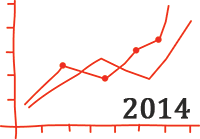Joanne Nelson looks ahead to the hot ICT trends for 2014. But this is no ordinary ‘new year predictions list.’ It is based on analysis of online conversations between IT leaders, professionals and influencers, so it’s completely free from sales bias.
ICT Trends 2014
It’s that time of year again, the press is awash with predictions for the technology year ahead - list after list predicting the big ICT trends for the year. The problem with all these lists, interesting though some undoubtedly are, is they are very rarely devoid of vested interest – all too often these lists are really just barely concealed self-promotion. That’s fine. It’s all part of the game, but in the end, the predictions end up more wish lists than real predictions.
So, I’m not going to use this blog to set out my own predictions. I’m going to use it to set out yours – CIOs’, CTOs’, IT teams’, analysts’ and journalists’. ‘How?’ you might ask. By analysing the content of online conversations between you all – we call it the Logicalis Trend Watch, and it provides a useful insight as to the top ICT trends for 2014, but completely free from the aforementioned ‘sales-bias.’
Of course, this kind of analysis is not just useful as an academic exercise. Understanding the trends, without adding our own priorities as a filter, plays a useful part in the process of understanding where the market is going, where customers may need support and so on. So, what are the top trends, as defined by conversations between technology experts and professionals online? They are:
1. Tech Decisions. Cloud computing and BYOD have significantly changed the role of technology within enterprise organisations over the past year. An increasing number of tech decisions are being made by sales, marketing and line-of-business managers, leaving CIOs and other IT professionals with concerns about maintaining control of corporate infrastructures, data and security as well as their own relevance within the organisation. This trend is echoed in the findings of a recent Logicalis research project, which are detailed in this post about the changing role of the CIO.
2. Big Data. Corporations have long realised the value of gathering and analysing data to foresee trends and react quickly to changes within key customer sets; in the coming year, enterprise organisations will turn to “big data” solutions as they rely even more heavily on collecting, storing, managing, filtering and deriving meaningful insights from data. The key is going to be doing it rather than simply acknowledging it.
3. The Internet of Things. Smart homes, smart cars, smart watches, smart TVs – the Internet of everything will proliferate in the coming year. Everything conceivable – from appliances to light bulbs – will be Internet-ready, and consumers will be able to control their lives via mobile devices. This means BYOD will become significantly more important and more complex as anything and everything becomes a “device” for Internet connectivity.
4. As-A-Service. With belt-tightening measures firmly in place, enterprise organisations that want to remain at the forefront of technology face a tremendous dilemma, which can be summed up in a simple question: ‘Cap-ex or op-ex?’ In the coming year, infrastructure restrictions will be less of a barrier to business growth as enterprises embraces the “as-a-service” concept and understand that it’s not the technology itself that transforms the business; it’s the way the business accesses and uses that technology that is transformative.
5. Mobility on the Move. As mobile applications replace traditional websites and software products, the combination of mobile and cloud will grow in significance. Mobile devices will become even more powerful and will be able to handle increasingly complex applications; at the same time applications will become increasingly mobile friendly. The proliferation of the cloud allows for collaboration, personalisation and mobile access to a large amount of data and a wide variety of products.
6. Advanced Infrastructure. Tech departments will begin to embrace the new, branching into advanced products like 3D printing, which can be used in a variety of applications and industries and has the potential to change the way things are produced or manufactured. This means a renewed focus on how these new technologies will be managed and supported, something already weighing heavily on the minds of enterprise IT professionals.
7. Hybrids. No surprises here: Hybrid clouds will emerge as the winners in private vs. public cloud debates.
8. IaaS. As the “as-a-service” movement takes root, the infrastructure-as-a-service or platform-as-a-service market will grow tremendously, particularly among software developers who want to speed application development, QA and solution deployment.
Clearly some of those trends are ripples, or waves, from previous years - indicating that Rome wasn’t built in a day, or big data wasn’t sorted in a year, but these are the trends that we have drawn out of your online conversations - there are of course many more. We’ll be featuring some them in an upcoming post, which will also be completely free from that pesky sales bias.
Elements of the findings set out here also appeared in CRN. Visit http://www.crn.com/240165308/printablearticle.htm to read the full article
Tech Trends for 2014 - on the other hand...

